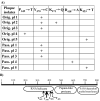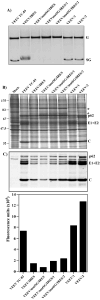IRES-dependent replication of Venezuelan equine encephalitis virus makes it highly attenuated and incapable of replicating in mosquito cells
- PMID: 18501401
- PMCID: PMC2483425
- DOI: 10.1016/j.virol.2008.04.020
IRES-dependent replication of Venezuelan equine encephalitis virus makes it highly attenuated and incapable of replicating in mosquito cells
Abstract
The development of infectious cDNA for different alphaviruses opened an opportunity to explore their attenuation by extensively modifying the viral genomes, an approach that might minimize or exclude the reversion to the wild-type, pathogenic phenotype. Moreover, the genomes of such alphaviruses can be engineered to contain RNA elements that would be functional only in cells of vertebrate, but not insect, origin. In the present study, we developed a recombinant VEEV that is more attenuated than TC-83 and capable of replicating only in vertebrate cells. This phenotype was achieved by rendering the translation of the viral structural proteins, and ultimately viral replication, dependent on the internal ribosome entry site of encephalomyocarditis virus (EMCV IRES). This recombinant virus was viable, but required additional, adaptive mutations in nsP2 that strongly increased its replication rates. In spite of efficient replication in cultured vertebrate cells, the genetically modified VEEV demonstrated a highly attenuated phenotype in newborn mice, and yet induced protective immunity against VEEV infection.
Figures








Similar articles
-
Hypervariable domain of nonstructural protein nsP3 of Venezuelan equine encephalitis virus determines cell-specific mode of virus replication.J Virol. 2013 Jul;87(13):7569-84. doi: 10.1128/JVI.00720-13. Epub 2013 May 1. J Virol. 2013. PMID: 23637407 Free PMC article.
-
Recombinant sindbis/Venezuelan equine encephalitis virus is highly attenuated and immunogenic.J Virol. 2003 Sep;77(17):9278-86. doi: 10.1128/jvi.77.17.9278-9286.2003. J Virol. 2003. PMID: 12915543 Free PMC article.
-
Interplay of acute and persistent infections caused by Venezuelan equine encephalitis virus encoding mutated capsid protein.J Virol. 2010 Oct;84(19):10004-15. doi: 10.1128/JVI.01151-10. Epub 2010 Jul 28. J Virol. 2010. PMID: 20668087 Free PMC article.
-
Venezuelan Equine Encephalitis Virus Capsid-The Clever Caper.Viruses. 2017 Sep 29;9(10):279. doi: 10.3390/v9100279. Viruses. 2017. PMID: 28961161 Free PMC article. Review.
-
Current Understanding of the Molecular Basis of Venezuelan Equine Encephalitis Virus Pathogenesis and Vaccine Development.Viruses. 2019 Feb 18;11(2):164. doi: 10.3390/v11020164. Viruses. 2019. PMID: 30781656 Free PMC article. Review.
Cited by
-
Type I interferon reaction to viral infection in interferon-competent, immortalized cell lines from the African fruit bat Eidolon helvum.PLoS One. 2011;6(11):e28131. doi: 10.1371/journal.pone.0028131. Epub 2011 Nov 30. PLoS One. 2011. PMID: 22140523 Free PMC article.
-
Attenuation of Chikungunya virus vaccine strain 181/clone 25 is determined by two amino acid substitutions in the E2 envelope glycoprotein.J Virol. 2012 Jun;86(11):6084-96. doi: 10.1128/JVI.06449-11. Epub 2012 Mar 28. J Virol. 2012. PMID: 22457519 Free PMC article.
-
Emerging viruses and current strategies for vaccine intervention.Clin Exp Immunol. 2019 May;196(2):157-166. doi: 10.1111/cei.13295. Clin Exp Immunol. 2019. PMID: 30993690 Free PMC article. Review.
-
Internal ribosome entry site-based attenuation of a flavivirus candidate vaccine and evaluation of the effect of beta interferon coexpression on vaccine properties.J Virol. 2014 Feb;88(4):2056-70. doi: 10.1128/JVI.03051-13. Epub 2013 Dec 4. J Virol. 2014. PMID: 24307589 Free PMC article.
-
Venezuelan equine encephalitis virus variants lacking transcription inhibitory functions demonstrate highly attenuated phenotype.J Virol. 2015 Jan;89(1):71-82. doi: 10.1128/JVI.02252-14. Epub 2014 Oct 15. J Virol. 2015. PMID: 25320296 Free PMC article.
References
-
- Alevizatos AC, McKinney RW, Feigin RD. Live, attenuated Venezuelan equine encephalomyelitis virus vaccine. I. Clinical effects in man. Am J Trop Med Hyg. 1967;16(6):762–8. - PubMed
-
- Berge TO, Banks IS, Tigertt WD. Attenuation of Venezuelan equine encephalomyelitis virus by in vitro cultivation in guinea pig heart cells. Am J Hyg. 1961;73:209–218.
-
- Blaney JE, Jr, Durbin AP, Murphy BR, Whitehead SS. Development of a live attenuated dengue virus vaccine using reverse genetics. Viral Immunol. 2006;19(1):10–32. - PubMed
Publication types
MeSH terms
Substances
Grants and funding
LinkOut - more resources
Full Text Sources
Other Literature Sources

